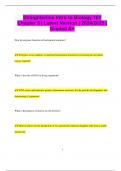Exam (elaborations)
Straighterline Intro to Biology 101 Chapter 5 | Latest Version | 2024/2025 | Graded A+
- Course
- Institution
Straighterline Intro to Biology 101 Chapter 5 | Latest Version | 2024/2025 | Graded A+ How do enzymes function in biochemical reactions? Enzymes act as catalysts to speed up biochemical reactions by lowering the activation energy required. What is the role of DNA in living organisms?...
[Show more]



